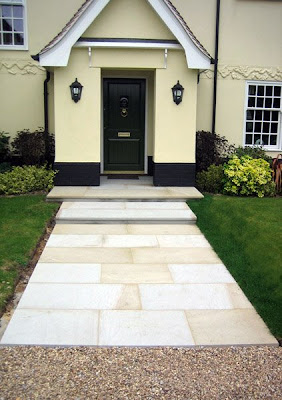
Creative Garden Path Ideas
We have all heard the saying about skipping down the primrose path to a life of ease and leisure. Thought this may not be feasible for most of us, a nice garden path in your yard can be. Garden paths are quite functional and rather easy to create with a variety of different items. Here are some ideas to consider when creating your path.
Strewing a number of flagstone steps through your garden can make it easy to walk through the area after a rain without soaked feet and also helps to reduce the effect of compacted soil. Flat stones, such as flagstones offer another benefit to your yard. By using them instead of concrete, it helps with rainwater runoff. Since water cannot penetrate concrete, using stones allows the water to soak into the ground around them.
When deciding on how to create your garden path, match it to the look of your home. A cottage-in-the-country look will be enhanced with the use of old bricks which show some weathering. If you seek to create more of a formal or contemporary atmosphere, newer brick is a better choice. The precise lines seen in some home designs are complimented by a stone path in a patchwork design.
When laying out the path, subtle curves are more appealing to the eye than straight lines. They can also allow a visitor wandering through the garden to be captivated by little surprises lying in wait along the journey. In addition to being more pleasing to the eyes, curved paths will allow a small area to seem larger than it really is.
If the pavers you choose for your path have straight, sharp edges, plants can help you soften the edges a bit. Insert small plants, such as thyme, in the cracks between the pavers. Add larger plants along the sides. As the plants spill over onto the pavers, they will help to soften the sharp edges along the side of the path. Fragrant plants such as lavender will increase the enjoyment when brushed up against and the fragrance is released.
Two important factors to keep in mind with a garden path are: keep it simple and make it look natural. If flagstones are the primary pavers along your path, randomly place larger sized smooth stones along the way and maybe incorporate smaller stones between the pavers. In doing so, the change of material will create areas of visual interest.
Lastly, don't forget to consider safety when planning your garden path. Lighting for evening and night time is one way to help keep the path safe for those who wander through it. Solar landscape lights add enough light to enable the traveler to see the road ahead, yet the light is soft and not overpowering in the evening, adding a bit of a romantic touch.
Strewing a number of flagstone steps through your garden can make it easy to walk through the area after a rain without soaked feet and also helps to reduce the effect of compacted soil. Flat stones, such as flagstones offer another benefit to your yard. By using them instead of concrete, it helps with rainwater runoff. Since water cannot penetrate concrete, using stones allows the water to soak into the ground around them.
When deciding on how to create your garden path, match it to the look of your home. A cottage-in-the-country look will be enhanced with the use of old bricks which show some weathering. If you seek to create more of a formal or contemporary atmosphere, newer brick is a better choice. The precise lines seen in some home designs are complimented by a stone path in a patchwork design.
When laying out the path, subtle curves are more appealing to the eye than straight lines. They can also allow a visitor wandering through the garden to be captivated by little surprises lying in wait along the journey. In addition to being more pleasing to the eyes, curved paths will allow a small area to seem larger than it really is.
If the pavers you choose for your path have straight, sharp edges, plants can help you soften the edges a bit. Insert small plants, such as thyme, in the cracks between the pavers. Add larger plants along the sides. As the plants spill over onto the pavers, they will help to soften the sharp edges along the side of the path. Fragrant plants such as lavender will increase the enjoyment when brushed up against and the fragrance is released.
Two important factors to keep in mind with a garden path are: keep it simple and make it look natural. If flagstones are the primary pavers along your path, randomly place larger sized smooth stones along the way and maybe incorporate smaller stones between the pavers. In doing so, the change of material will create areas of visual interest.
Lastly, don't forget to consider safety when planning your garden path. Lighting for evening and night time is one way to help keep the path safe for those who wander through it. Solar landscape lights add enough light to enable the traveler to see the road ahead, yet the light is soft and not overpowering in the evening, adding a bit of a romantic touch.
Labels:
0 comments:
Post a Comment